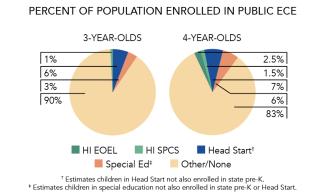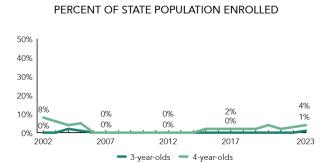
State of Preschool
Hawaii
Access Rankings
Resource Rankings
Total Benchmarks Met
Overview

During the 2022-2023 school year, Hawaii preschool enrolled 704 children, an increase of 155 from the prior year. State spending totaled $7,516,239, up $140,914 (2%), adjusted for inflation, since last year. State spending per child equaled $10,676 in 2022-2023, down $2,758 from 2021-2022, adjusted for inflation. Hawaii met 10 of 10 quality standards benchmarks.
What's New
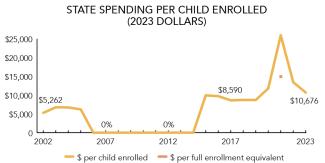
The State of Hawaii is planning to add up to 44 new Executive Office on Early Learning EOEL Public Prekindergarten Program classrooms, which will allow up to 880 additional students to enroll in the EOEL Public Prekindergarten Program during the 2024-2025 school year. Additionally, 30 new State Public Charter School Early Learning classrooms (SPCSC) are planned for charter schools, adding up to 600 new pre-K seats. Combined, Hawaii is looking to add 1,480 more public pre-K slots in the 2024-2025 school year.
Through HB961, the legislature added $38.8 million to the Preschool Open Doors (POD) childcare tuition subsidy program for community-based childcare providers. The funding will allow POD to expand their subsidy eligibility to include three-year-olds beginning August 2024. This bill also allows more families to be eligible by expanding the income criteria up to 300% FPL.
Taking a multi-faceted approach, the State of Hawaii, through the legislature, recognized the need to grow the early childhood educator workforce simultaneously. The Early Childhood Educator Stipend Program was established by the legislature through Act 210 Sessions Law Hawaii 2021. A generous donation from the Samuel N. and Mary Castle Foundation funded it. In 2023, the legislature approved $600,000 in additional funding to support our Early Childhood Educator Stipend program, which now becomes the first publicly funded tuition stipend program available to current and future practitioners in the early childhood field for Hawaiian and English medium teacher preparation pathways. This tuition stipend program aims to help increase the qualifications of our ECE workforce. It seeks individuals who will commit to work in early care and education services directly to children from birth through five years of age for at least two consecutive years in one of the early learning systems described in HRS § 302L-2. This program includes Hawaiian language medium and immersion settings and early learning settings at charter schools. Stipend awardees who keep this commitment will pay nothing back.
The Hawaii State Legislature, through Act 257, Sessions Laws of Hawaii 2022, appropriated $200 million for the School Facilities Authority to add or expand access to prekindergarten for eligible children across the state for the fiscal year 2022-2023. In January 2023, Hawaii was awarded a federal Preschool Development Grant Birth through Five (PDG B–5) renewal grant for $6.6 million. The University of Hawaii Systems is the lead in this grant.
Background
In Hawaii, the Executive Office on Early Learning (EOEL) Public Prekindergarten Program serves 3- and 4-year-old children, with priority given to students considered “at-risk,” including those from low-income families, now defined as 300% FPL. The EOEL Public Prekindergarten Program is required to operate on the same schedule as public elementary schools, providing services for 1,080 hours a year. EOEL expanded its eligibility to include three- and four-year-olds in the 2022-2023 school year.
Beginning in SY 2020-2021, through Act 46, SLH 2020, the legislature gave statutory authority to the State Public Charter School Commission to administer the early learning program in charter schools. Act 46, SLH 2020 also changed the eligibility criteria to include three- and four-year-old children.
Teachers in the EOEL Public Prekindergarten Program and the Hawaii State Public Charter School (SPCSC) Early Learning Program are part of the Hawaii State Teachers Association and, as such, receive salary and benefit parity with teachers in K–12 classrooms. Lead teachers in both programs are required to have a bachelor’s degree with licensure in ECE, while assistant teachers are required to have a CDA credential or coursework for a certificate that meets the requirements for child development associate credential preparation. The EOEL Public Prekindergarten Program and the SPCSC Early Learning Program classrooms receive CLASS observations twice a year, and formative child assessments using Teaching Strategies GOLD are conducted throughout the year with three checkpoints. In addition, all programs undergo fiscal monitoring annually, and program records are reviewed more than once per year.
Hawaii’s overall support for state-funded preschool, including enrollment and funding for EOEL and SPCSC, is depicted in the first two sections of the state profile. The third section focuses solely on EOEL, and the fourth on the SPCSC.
-
Access

Total state pre-K enrollment 704 Special education enrollment, ages 3 and 4 1,827 Federally funded Head Start enrollment, ages 3 and 4 2,136 State-funded Head Start enrollment, ages 3 and 4 0 Resources
Total state pre-K spending $7,516,239 State Head Start spending $0 State spending per child enrolled $10,676 All reported spending per child enrolled* $10,676 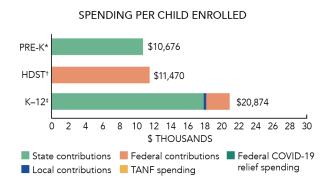
*Pre-K programs may receive additional funds from federal or local sources that are not included in this figure. †Head Start per-child spending includes funding only for 3- and 4-year-olds. ‡K–12 expenditures include capital spending as well as current operating expenditures.
-
Access
Resources
Total state pre-K spending $5,657,492 Local match required? No State spending per child enrolled $13,428 All reported spending per child enrolled* $14,888 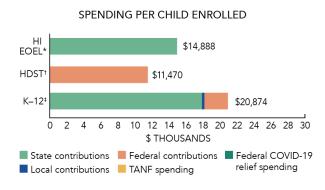
*Pre-K programs may receive additional funds from federal or local sources that are not included in this figure. †Head Start per-child spending includes funding only for 3- and 4-year-olds. ‡K–12 expenditures include capital spending as well as current operating expenditures.
Hawaii's Executive Office on Early Learning Public Prekindergarten Quality Standards Checklist
| Policy | HI EOEL Requirement | Benchmark | Meets Benchmark? |
|---|---|---|---|
For more information about the benchmarks, see the Executive Summary and the Roadmap to State pages. | 10benchmarks met | ||
| Early Learning & Development Standards Benchmark | Comprehensive, aligned, supported, culturally sensitive | Comprehensive, aligned, supported, culturally sensitive | |
| Curriculum Supports Benchmark | Approval process & supports | Approval process & supports | |
| Teacher Degree Benchmark | BA | BA | |
| Teacher Specialized Training Benchmark | ECE, CD | Specializing in pre-K | |
| Assistant Teacher Degree Benchmark | CDA | CDA or equivalent | |
| Staff Professional Development Benchmark | 10 PD sessions/year (teachers & assistants); PD plans; Coaching | For teachers & assistants: At least 15 hours/year; individual PD plans; coaching | |
| Maximum Class Size Benchmark | 20 (4-year-olds) | 20 or lower | |
| Staff to Child Ratio Benchmark | 1:10 (4-year-olds) | 1:10 or better | |
| Screening & Referral Benchmark | Full physical exam (includes vision & hearing) | Vision, hearing & health screenings; & referral | |
| Continuous Quality Improvement System Benchmark | Structured classroom observations; Data used for program improvement | Structured classroom observations; data used for program improvement | |
-
Access
Resources
Total state pre-K spending $1,858,747 Local match required? No State spending per child enrolled $5,737 All reported spending per child enrolled* $5,737 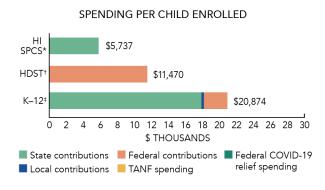
*Pre-K programs may receive additional funds from federal or local sources that are not included in this figure. †Head Start per-child spending includes funding only for 3- and 4-year-olds. ‡K–12 expenditures include capital spending as well as current operating expenditures.
Hawaii State Public Charter School Early Learning Program Quality Standards Checklist
| Policy | HI SPCSP Requirement | Benchmark | Meets Benchmark? |
|---|---|---|---|
For more information about the benchmarks, see the Executive Summary and the Roadmap to State pages. | 10benchmarks met | ||
| Early Learning & Development Standards Benchmark | Comprehensive, aligned, supported, culturally sensitive | Comprehensive, aligned, supported, culturally sensitive | |
| Curriculum Supports Benchmark | Approval process & supports | Approval process & supports | |
| Teacher Degree Benchmark | BA* | BA | |
| Teacher Specialized Training Benchmark | ECE, CD | Specializing in pre-K | |
| Assistant Teacher Degree Benchmark | CDA | CDA or equivalent | |
| Staff Professional Development Benchmark | 60 hours/year (teachers & assistants); PD plans, Coaching | For teachers & assistants: At least 15 hours/year; individual PD plans; coaching | |
| Maximum Class Size Benchmark | 20 (3- & 4-year-olds) | 20 or lower | |
| Staff to Child Ratio Benchmark | 1:10 (3- & 4-year-olds) | 1:10 or better | |
| Screening & Referral Benchmark | Full physical exam (includes vision & hearing) | Vision, hearing & health screenings; & referral | |
| Continuous Quality Improvement System Benchmark | Structured classroom observations; Data used for program improvement | Structured classroom observations; data used for program improvement | |
